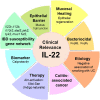Clinical importance of IL-22 cascade in IBD
- PMID: 29075900
- PMCID: PMC5866830
- DOI: 10.1007/s00535-017-1401-7
Clinical importance of IL-22 cascade in IBD
Abstract
IL-22 is a relatively new cytokine that is characterized by several unique biological properties. In the intestines, the effect of IL-22 is restricted mainly to non-lymphoid cells such as epithelial cells. Interestingly, the expression pattern and major cellular source of IL-22 have distinct difference between large and small intestines. IL-22 possesses an ability to constitutively activate STAT3 for promoting epithelial cell regeneration and reinforcing mucosal barrier integrity through stimulating the expression of anti-bacterial peptide and mucins. Of note, IL-22 is characterized as a two-faced cytokine that can play not only protective but also deleterious roles in the intestinal inflammation depending on the cytokine environment such as the expression levels of IL-23, T-bet, and IL-22 binding protein. Most importantly, clinical relevance of IL-22 to inflammatory bowel disease has been well highlighted. Mucosal healing, which represents the current therapeutic goal for IBD, can be induced by IL-22. Indeed, indigo naturalis, which can activate IL-22 pathway through Ahr, has been shown in a clinical trial to exhibit a strong therapeutic effect on ulcerative colitis. Despite the beneficial effect of IL-22, continuous activation of the IL-22 pathway increases the risk of colitis-associated cancer, particularly in patients with an extended history of IBD. This review article discusses how IL-22 regulates colitis, how beneficial versus deleterious effects of IL-22 is determined, and why IL-22 represents a promising target for IBD therapy.
Keywords: Ahr; IL-22BP; IL-23; Indigo naturalis; Mucus.
Conflict of interest statement
The authors declare that they have no conflict of interest.
Figures


Similar articles
-
Healing of intestinal inflammation by IL-22.Inflamm Bowel Dis. 2012 Sep;18(9):1777-84. doi: 10.1002/ibd.22929. Epub 2012 Feb 22. Inflamm Bowel Dis. 2012. PMID: 22359410 Free PMC article. Review.
-
Role of interleukin-22 in inflammatory bowel disease.World J Gastroenterol. 2014 Dec 28;20(48):18177-88. doi: 10.3748/wjg.v20.i48.18177. World J Gastroenterol. 2014. PMID: 25561785 Free PMC article. Review.
-
ATF3 Sustains IL-22-Induced STAT3 Phosphorylation to Maintain Mucosal Immunity Through Inhibiting Phosphatases.Front Immunol. 2018 Nov 5;9:2522. doi: 10.3389/fimmu.2018.02522. eCollection 2018. Front Immunol. 2018. PMID: 30455690 Free PMC article.
-
STAT3 and its activators in intestinal defense and mucosal homeostasis.Curr Opin Gastroenterol. 2010 Mar;26(2):109-15. doi: 10.1097/MOG.0b013e3283365279. Curr Opin Gastroenterol. 2010. PMID: 20040863 Review.
-
Biologic therapy for inflammatory bowel disease.Drugs. 2005;65(16):2253-86. doi: 10.2165/00003495-200565160-00002. Drugs. 2005. PMID: 16266194 Review.
Cited by
-
IL-22BP production is heterogeneously distributed in Crohn's disease.Front Immunol. 2022 Oct 13;13:1034570. doi: 10.3389/fimmu.2022.1034570. eCollection 2022. Front Immunol. 2022. PMID: 36311796 Free PMC article.
-
Immunological Networks Defining the Heterogeneity of Inflammatory Bowel Diseases.J Crohns Colitis. 2021 Nov 8;15(11):1959-1973. doi: 10.1093/ecco-jcc/jjab085. J Crohns Colitis. 2021. PMID: 33959743 Free PMC article.
-
Cytokine induced inflammatory bowel disease model using organ-on-a-chip technology.PLoS One. 2023 Dec 13;18(12):e0289314. doi: 10.1371/journal.pone.0289314. eCollection 2023. PLoS One. 2023. PMID: 38091316 Free PMC article.
-
Bacteroides fragilis strain ZY-312 promotes intestinal barrier integrity via upregulating the STAT3 pathway in a radiation-induced intestinal injury mouse model.Front Nutr. 2022 Dec 15;9:1063699. doi: 10.3389/fnut.2022.1063699. eCollection 2022. Front Nutr. 2022. PMID: 36590229 Free PMC article.
-
Epithelial Traffic Control: IL22 Gives TA Cells the Green Light.Cell Mol Gastroenterol Hepatol. 2019;7(2):409-410. doi: 10.1016/j.jcmgh.2018.10.004. Epub 2018 Oct 30. Cell Mol Gastroenterol Hepatol. 2019. PMID: 30739858 Free PMC article. No abstract available.
References
Publication types
MeSH terms
Substances
Grants and funding
LinkOut - more resources
Full Text Sources
Other Literature Sources
Miscellaneous

